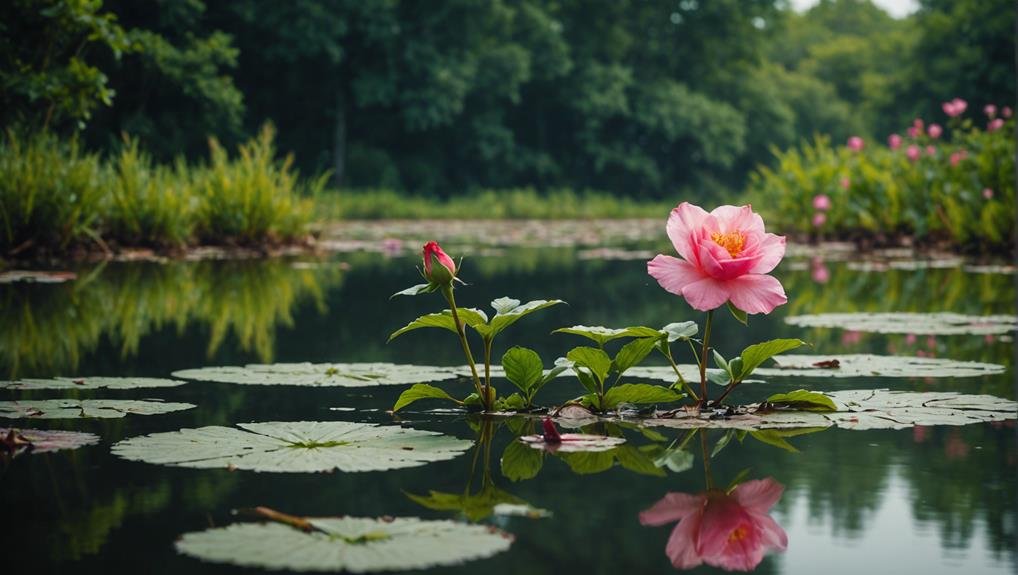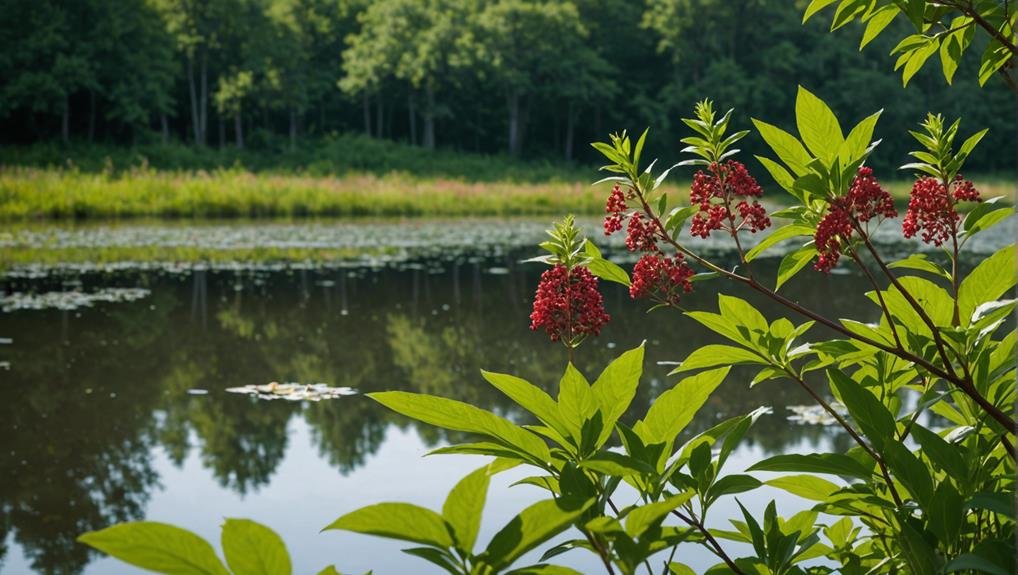Water-loving trees and plants, like the Atlantic White Cedar and River Birch, thrive in waterlogged soils, absorbing significant water amounts. Black Gum and Red Maple are perfect for moist, slightly acidic conditions and help prevent soil erosion. Adding vibrant colors to wet areas, the French Rose and Swamp Hibiscus support local wildlife such as bees and butterflies. Bigleaf Hydrangea and Common Winterberry do well in consistently moist soils, enriching biodiversity with their colorful flowers and berries. Red Elderberry and Swamp Milkweed further enhance wetland habitats, benefiting birds and Monarch butterflies. It's fascinating to explore the remarkable adaptations of these plants in supporting their ecosystems.
Atlantic White Cedar and River Birch
In swampy and wetland environments, the Atlantic White Cedar (Chamaecyparis thyoides) and River Birch (Betula nigra) are excellent examples of trees that thrive in waterlogged soil conditions. These native species have evolved specific adaptations to survive in their watery habitats. The Atlantic White Cedar, commonly found on elevated areas in swamps and bogs, has impressive water absorption abilities. Similarly, the River Birch, capable of growing up to 80 feet tall, can tolerate poor drainage and flourishes in these damp settings. Both trees are crucial for maintaining the ecological balance of their native habitats by efficiently soaking up excess water, thereby preventing soil erosion and supporting a diverse array of wetland plants and animals.
Black Gum and Red Maple
Black Gum (Nyssa sylvatica) and Red Maple (Acer rubrum) are excellent choices for areas with moist, slightly acidic soils and water accumulation. Black Gum is famous for its stunning red, orange, and yellow fall foliage, adding beauty to landscapes and attracting bees and birds, promoting biodiversity. Red Maple, on the other hand, grows rapidly and can reach heights of 90-120 feet, showcasing vibrant red leaves in the autumn. Both trees are efficient at absorbing water, with Red Maple capable of absorbing at least 5 gallons per week, making them valuable for wet environments. These species not only enhance the visual appeal of landscapes but also contribute to ecological stability by supporting wildlife and managing water levels effectively.
French Rose and Swamp Hibiscus

French Rose (Rosa gallica) and Swamp Hibiscus (Hibiscus moscheutos) are exceptional water-loving plants that thrive in damp, poorly drained soils, bringing vivid colors to any landscape. French Rose boasts striking deep pink blooms, flourishing in full sun during late spring and early summer. With a height of up to 5 feet and a compact growth habit, it adds a charming touch. On the other hand, Swamp Hibiscus, resilient in USDA zones 5-9, showcases large pink flowers from mid-summer to early fall, reaching impressive heights of 7 feet. These plants not only beautify the surroundings but also attract beneficial wildlife; French Rose entices bees, while Swamp Hibiscus magnetizes butterflies and hummingbirds with its allure.
Bigleaf Hydrangea and Common Winterberry
Bigleaf Hydrangea (Hydrangea macrophylla) and Common Winterberry (Ilex verticillata) are known for thriving in consistently moist or poorly drained soils, making them valuable additions to water-logged landscapes. Bigleaf Hydrangeas are particularly interesting because their flower colors change based on soil pH—blue in acidic soils and pink in alkaline ones, adding a dynamic element to any garden. On the other hand, Common Winterberry offers vibrant red berries that last through winter, providing visual interest and food for wildlife. These color changes in the berries enhance their appeal in natural settings. Both plants are native to North America and well-suited to wet conditions.
Red Elderberry and Swamp Milkweed

Red Elderberry (Sambucus racemosa) and Swamp Milkweed (Asclepias incarnata) are two plants that thrive in wetland environments, playing vital roles in their ecosystems. Red Elderberry, originally from Europe, Asia, and North America, can reach heights of up to 12 feet and produces small fruits that birds love. These fruits are essential for various avian species. On the other hand, Swamp Milkweed, native to North America, flourishes in wet soil and is particularly attractive to Monarch butterflies, offering them crucial habitat and a nectar source. Moreover, Swamp Milkweed is resistant to deer, making it a durable option for promoting biodiversity in wetland areas. Both plants support local wildlife and contribute to the overall ecological well-being of their habitats.
Conclusion
In summary, trees and plants that thrive in wet environments like Atlantic White Cedar, River Birch, Black Gum, and Red Maple play a crucial role as natural sponges, effectively managing excess water in various ecosystems. These plant species not only help prevent flooding and improve drainage but also support biodiversity and enhance the beauty of landscapes with their vibrant foliage and flowers. Understanding the unique adaptations and ecological functions of these water-loving plants highlights their significance in landscape maintenance and environmental conservation endeavors.

